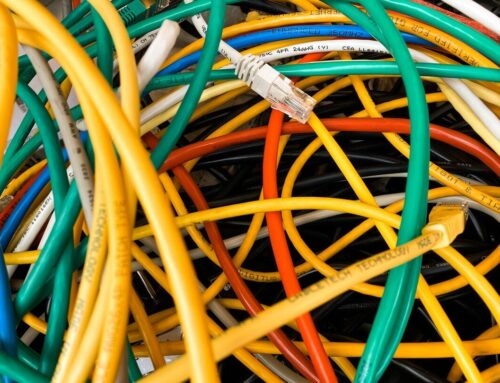Have you ever been frustrated by slow internet speeds or data bottlenecks during critical work hours? In our rapidly advancing digital era, efficient data transmission has become pivotal for business success.
Structured cabling installation is not merely an upgrade. It’s a transformative approach to how your business handles its entire IT infrastructure. Imagine a system where every device and communication line works in perfect harmony, offering speed and reliability that pushes your operational capacity to new heights.
This article dives deep into how structured cabling can streamline your operations, significantly increase your bandwidth, and ensure your business is equipped for future technological advancements. Keep reading to understand why installing a structured cabling system is a strategic move that could redefine your business landscape.
What is Structured Cabling?
Structured cabling is a standardized approach to cabling infrastructure in buildings. It’s designed to support various hardware uses. Structured cabling is organized into six subsystems:
- Entrance facilities
- Equipment rooms
- Backbone cabling
- Horizontal cabling
- Telecommunications rooms
- Work area components
This method ensures that all telecommunication wiring within a building is systematically managed, making it easier to maintain and upgrade.
The components of structured cabling include twisted pair cables like Cat 5 and Cat 6, as well as fiber optic cables. Cat 5 and Cat 6 are commonly used for horizontal cabling within floors to connect workstations to network hubs.
Fiber optic cables, on the other hand, are used for backbone cabling. This links different equipment rooms and floors due to their high bandwidth capabilities and ability to transmit data over long distances without significant loss.
Benefits of Structured Cabling Installation
In today’s technology-driven market, the efficiency of your network infrastructure could mean the difference between success and stagnation. Structured cabling installation offers a plethora of benefits that extend beyond mere connectivity.
Improved Network Performance
Structured cabling installation offers a significant boost in network performance. With a well-organized cabling system, businesses can achieve consistent, high-speed connectivity that supports demanding applications.
For instance, a structured cabling system can handle increased bandwidth to accommodate modern telecommunication needs without interruptions. This leads to reduced downtime and maintenance.
Scalability and Flexibility
One of the major advantages of structured cabling is its scalability. As your business grows, you can easily expand your network without overhauling the entire infrastructure. This flexibility supports future technology advancements by allowing businesses to integrate new devices and systems seamlessly.
Whether you’re adding new workstations, upgrading to faster network speeds, or incorporating advanced audio systems, a structured cabling system can adapt to your needs.
For example, when a company moves to a new office or expands its current space, structured cabling allows for quick adjustments and installations. This adaptability not only saves time but also reduces costs associated with extensive rewiring.
Cost Efficiency
Structured cabling is also cost-efficient. While the initial installation might require an investment, the long-term benefits outweigh the costs. With a structured system, maintenance and replacement costs are lower because the infrastructure is organized and standardized. Technicians can easily identify and fix issues which leads to improved troubleshooting and decreased downtime.
Moreover, structured cabling reduces the installation time for new devices. When adding new equipment, the existing cabling infrastructure can be used, eliminating the need for new wiring. This efficiency translates to significant cost savings over the life of the system.
How Structured Cabling Enhances Business Efficiency
A well-designed structured cabling system is more than just wires and cables. It’s a crucial enhancer of daily business operations. This section goes into the significant impact structured cabling has on business efficiency.
Streamlined Communication
Structured cabling enhances business efficiency by streamlining communication. It supports various communication systems, including voice, data, and video. This ensures that all forms of communication are reliable and efficient.
With a structured cabling system, businesses can integrate advanced communication tools, such as VoIP phones and video conferencing systems, to improve collaboration among employees.
For example, a structured cabling system can support high-quality audio systems in conference rooms to allow for clear and effective meetings. This improved communication infrastructure helps teams stay connected and work more efficiently.
Increased Productivity
Faster data transfer speeds are another key benefit of structured cabling. High-speed connectivity ensures that employees can access and share information quickly, leading to increased productivity.
A reliable network supports continuous operations and prevents delays caused by network issues.
Enhanced Security
Security is a critical concern for any business. Structured cabling provides secure transmission of data to protect sensitive information from potential breaches. It also allows for the integration of security systems, such as surveillance cameras and access controls to enhance the overall security of the business premises.
For instance, a structured cabling system can support a network of security cameras throughout a building to ensure comprehensive surveillance coverage. This integration not only improves physical security but also protects digital assets by preventing unauthorized access to the network.
Implementation Considerations
Implementing a structured cabling system requires careful planning and professional installation. The layout of the building and future needs must be considered to ensure the system meets current and future requirements.
Professional installers, who are certified and experienced, play a crucial role in the successful implementation of structured cabling.
Factors such as the building’s design, the types of devices to be connected, and potential future expansions need to be evaluated. Certified technicians can design a system that maximizes efficiency and provides a reliable network foundation. Their expertise ensures that the installation is done correctly to minimize the risk of issues down the line.
Future-Proof Your Infrastructure with Professional Cabling Solutions
Structured cabling installation stands as the backbone of modern telecommunications, supporting everything from audio systems to complex data centers. It significantly reduces troubleshooting time and minimizes downtime. By investing in structured cabling, businesses can enjoy increased bandwidth and a future-proof network that grows with their needs.
At Briggs A/V Solutions, we specialize in creating customized, high-performance structured cabling systems that are tailored to your specific requirements. As the leading A/V provider in Middle Tennessee, our expertise ensures that your installation is seamless and professionally managed from start to finish.
Contact us today for a free consultation and take the first step towards a more efficient and secure business environment.






